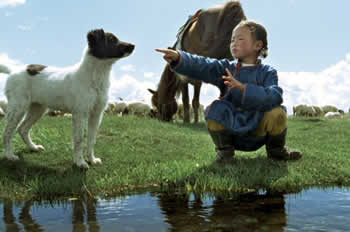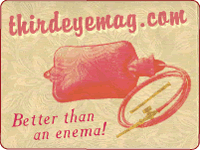
When at its best, cinema transports its audience to another time and place, freeing the throngs of weary cubicle-dwellers from the throes of their everyday existence. A film usually does this in one of two ways: by providing a penetrating look at our own world that is somehow more real than the reality it portrays, or by offering entry into a fantasy realm—a world of imagination recognizable by virtue of its being unrecognizable. The Cave of the Yellow Dog, a genre-blurring docudrama about a real family scratching out a traditional existence on the desolate plains of Mongolia, does both.
This is a world of herding, mountains, fields, and silence, where a man discusses with his friends the growing threat of wolves before hopping on a shockingly out-of-place moped and riding off to sell sheepskins in the city.
The film was written and directed by Mongolian filmmaker Byambasuren Davaa, although it is never clear just how much writing was involved. Due to the nature of the events that unfold, the story must have been scripted, but the family’s “acting” (especially that of the little children) seems far too natural to have been contrived. The plot follows a young girl whose father forbids her to keep a stray dog she finds in a nearby cave, set against the backdrop of the family’s isolated and precarious pastoral lifestyle. This is a world of herding, mountains, fields, and silence, where a man discusses with his friends the growing threat of wolves before hopping on a shockingly out-of-place moped and riding off to sell sheepskins in the city. When he returns with a few small gifts, including a garishly modern plastic pot, we see two worlds brush clumsily up against one another.
The cinematography adds to the documentary feel by utilizing exclusively fixed camera techniques—no handhelds or zooms, and few if any pans. By holding almost every shot just a few seconds longer than expected, Davaa seems to stare at her subjects, unable to pry her eyes away from the muted wonders of this way of life—the elegant movements of the mother, the intricate details of the family’s home, the captivating drudgery of making cheese. In so doing, the film thumbs its nose at the short attention span of the multiplex audience and rewards the patient viewer with a glimpse into a real-life fantasy world. And when, in the very last scene, a government vehicle—loudspeakers blasting, exhorting all in earshot to vote in the next election—passes the family on a worn dirt road, we are reminded just how close that world is to ours.





No Comments so far ↓
There are no comments yet...Kick things off by filling out the form below.